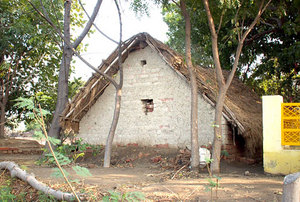“Competitors work toward one goal: a picture-perfect triple jump, regardless of the wear and tear on the ankles, knees and hips.” (Jackson Jr., Harry) Harry Jackson Jr. captures the thinking process of many young skaters with this quote. Despite continuous and painful injury to the knee, a serious skater will pursue dreams such as landing an axel, a double, or even the elusive quadruple. Jumping these kinds of jumps can be very dangerous if done incorrectly.
The knee, which is the largest joint in the body, comes under extensive stress during activities such as figure skating. The ligaments in the knee are responsible for holding the knee securely when a force is applied. This force is supplied by the quadriceps and varies depending on the skaters’ physical conditioning. Ligaments are tough bands of tissue which connect the end of bones together. The two basic types of ligaments in the knee are the collateral ligament and the cruciate. Both collateral ligaments prevent unwanted side to side motions in the knee. Injury to these ligaments may cause the joint shift into a position which is not vertically over the knee. Upon landing a jump in this position, the knee can suffer further damage in the ligaments. The two types of collateral ligaments are the medial (MCL), which is inside the knee and the lateral (LCL) which is on the outside of the knee. There are also two types of cruciate ligaments; the anterior (ACL) and posterior (PCL). Cruciate refers to the way in which both ligaments cross, in the shape of an X. Both ligaments are held inside of the knee and prevent the joint from sliding forward or backwards under the femur. A partial or complete tear is possible when a ligament injury happens.
The most common injury to the ligaments is an ACL injury. Because of anatomical injuries and muscle functioning, ACL injuries are more common among women then men. Children are subject to tearing the ligament with a piece of bone still attached, requiring the bone to be set correctly. An adult may need physical therapy to heal a ligament injury to avoid the onset of early arthritis in the affected knee. Any tear in these ligaments is considered tendonitis, which is commonly referred to as jumper’s knee. Tendonitis is an inflammation of the ligament and surrounding tissues. When the knee is injured, the joint fills up with blood and fluids. This can tighten up the joint and decrease range of motion. Tendonitis can also cause pain at the bottom and front of the kneecap. Another common symptom on patellar tendonitis is weakness in the calf muscle.
The career of a figure skater is often begun in early childhood with on ice training. The basics skills that are learned first allow the skater to become comfortable on skates without subjecting their joints to a lot of stress. By the time that a skater reaches a level of advanced moves and jumps, they are usually growing rapidly. Injuries during this period can cause long term damage in skaters such as stunted growth (“Intensive Training and Sports Specialization in Young Athletes”, 154). Repeated jumping can strain the quadricep muscle if it is not properly conditioned, eventually leading to micro teams. The tiny tears in the muscle lead to degeneration of the collagen (Jumpers Knee).
Improper technique is one of the most dangerous causes of knee injury in figure skaters. By rushing through the basics, a skater can ultimately hurt their chances of being a good skater. The thought of landing a double often leads girls to attempting a jump before they are ready. Although the set up of a jump is the most important in the outcome of the jump, the landing is what usually causes an injury (Puddy). Each jump subjects the skater’s knee to eight times her body weight (Pecina) and increases the pressure on the ligaments if they are out of place at the time of landing. This much weight on one knee requires correct technique, to avoid injury.
Jumps with two or more rotations need more height to give the skater time for complete rotation. Injury can easily occur during high jumps which are not completed. (Read) The axel jump can be especially harmful to the joints of a skater when it is popped. Popping a jump is when the set-up and take-off are completed but the jump is not rotated. A popped jump is often landed on two feet or in the wrong direction. It is often easier and safer for the skater to allow themselves to fall than try to save the landing. If a single footed landing is attempted in the wrong direction it can shift the knee so that it is not vertically over the foot and cause injury. To avoid this type of knee injury, a skater should never attempt a jump without proper instruction. Many skaters try to teach themselves difficult jumps and end up injuring their joints which stops them from progressing any further. The best way to keep your body safe is to practice correct technique on basic moves before moving on.
Buying a skate is often the first step in the sport of figure skating and often the most confusing. As with any sport, the equipment used in figure skating is very important to the athletes’ safety. The cost of figure skates ranges from recreational skates under $50 to custom made skates costing more than $600. The inexpensive skate is for an occasional skater who doesn’t need much ankle support. A boot of this type usually comes with a basic blade attached. A high priced skate is only for an advanced skater attempting difficult jumps which require ample ankle support. Because the needs of a skater are individual to their body type, foot shape and ability, a custom skate is ideal for a committed skater. Figure skates are the heaviest type of skate because the boot comes up high on the calf to provide support. A properly fit boot should be snug with absolutely no movement in the heel (Puddy). When a skater has a well fitting boot, they are able to hold their knees stable and decrease the risk of injury to the ligaments and tendons (The Skeleton, Fantastic Framework). Buying a boot is a substantial investment and can be made easier with the assistance of a coach.
The biggest mistake that a new skater makes is buying a boot which is too stiff and too expensive. Many parents want to buy their child the best and most expensive boot when really that boot could be hurting them. The boot of a figure skate is made of “sturdy leather with stiffening supports in the heel and under the arch “(Ice Skating). The stiff boot can cause pain while it is being broken in and may push a new skater away the sport. Now the skater is left with expensive, stiff boots which they will never use. Parents should be aware that the price of a boot does not determine how well it will suit their child. Usually a boot costs more because of the additional padding and higher quality of leather.
The next step in becoming a well-equipped figure skater is buying a blade. Although some lower level blades come with the boot, many must be purchased separately. The blade of a figure skate is slightly concave, creating two edges” (Ice Skating). The toe pick is an important part of the blade that is at the front of the blade and assists a skater with certain jumps and moves. The design of the toe pick has evolved over hundreds of years to provide the maximum flexibility and range of possibility.” (Ice Skating). Apart from the actual design of the blade, placement is key. Incorrect placement of the blade can make it hard for a skater to perform correct edges (Janowicz). “A properly placed blade to a boot is like neutral position to an orthodic casting” (Janowicz).
Over time jumpers’ knee can cause a serious and potentially debilitating injury. “Injuries in elite athletics are compounded by the pressure to return to competitions” (Roberts). This type of overuse injury affects over 40% of female junior elite skaters (Foster). Recently, there has been an increase in the number of children training in a specific sport year round which contributes to overuse symptoms (Lindskog).
The immediate symptoms of an overuse injury in the knee include sudden sever pain and swelling (Leadbetter). Eventually, it can result in loss of function and decrease in range of motion (Leadbetter). If a skater notices pain or swelling while skating, she should stop skating and relax the joint for a couple of days. Many skaters will ignore the pain and continue to skate because of the pressure of competition. This can cause a more serious injury to the ligament which may require physical therapy. Treatment and or rehabilitation of a sports injury must be specific to the athlete and sport (Roberts). While an average person would require therapy three times a week, a pressured athlete may undergo therapy up to three times a day (Roberts).
Off-ice training can also result in injury. The stress on your knees on ice is very high and off-ice jumping increased the stress on your joints. Researchers have discovered that most injuries are caused off-ice rather than on (Janowicz). Conditioning off-ice is the first step to safe training. A popular “second sport” among figure skater is gymnastics, which is beneficial to a skater’s muscles, flexibility and stamina. On the other side, gymnastics incorporates different techniques than figure skating and may be confusing to a skater. The extreme stress on the joints is also a negative side of gymnastics (Schulman). Plyometrics is a safer type of off ice training for figure skaters. It is a type of jumping exercise which utilizes the body’s ability to store and release energy (Schulman).
Many of the injuries to a skater’s tendons and ligaments can be easily prevented. The first few things which a skater learns may seem insignificant, but really they determine the future of a skater. By not practicing things like edges and crossovers, the athlete will have weak set-ups and take-offs even for single jumps. Double and triple jumps only increase the amount of damage that can be done to the knee. By learning correct skill, rate of injury can be decreased. Overuse and poor conditioning also contribute to many injuries among young figure skaters. The last preventable mistake in skating is usually the most overlooked, equipment. By following this advice, any skater level can avoid potentially debilitating patellar tendonitis.
Glossary
Axel – A jump on which the skater takes off from the forward inside edge and lands on the back outside edge of the opposite foot. There are single, double and triple versions.
Concave – Curving inward.
Elite – Figure skaters compete in multiple levels, from novice to elite.
Plyometric – A form of training designed to improve your explosive strength.
Tendonitis – an inflammation in a tendon or the tendon covering.
Toe pick – the teeth at the front of each skate blade that are often used in jumps and spins.
Worked Cited
Donahue, Parnell M.D., Sports Doc, New York: Alfred A Knopf Inc, 1970
Foster, Jordana Bieze.”Biomechanics in Sports Injury”
Journal of Biomechanics Vol 4:1 (2007):pg 33
Francis, Carl C., Introduction to Human Anatomy, Saint Louis, The C.V. Mosley Company, 1964
“Ice Skating” Academic American Encyclopedia 1996 ed.
Pgs 13-14
“Ice Skating” World Book 2003 edition, pgs 10-16
Jackson Jr., Harry. “Ice Skating Injuries: What to Expect.” Active.com. 20 January.2006.ESPN.22Apr2007.
Janowicz, Rachael A How to Evaluate Figure Skating Injuries. 17
March 2007 Jumper Knee, 14 March 2007 cybertherapist/front/knee/indexjumpersknee.html
MD, Leadbetter, Wayne B. Tendon Injuries: Basic Science and
Clinical Management



